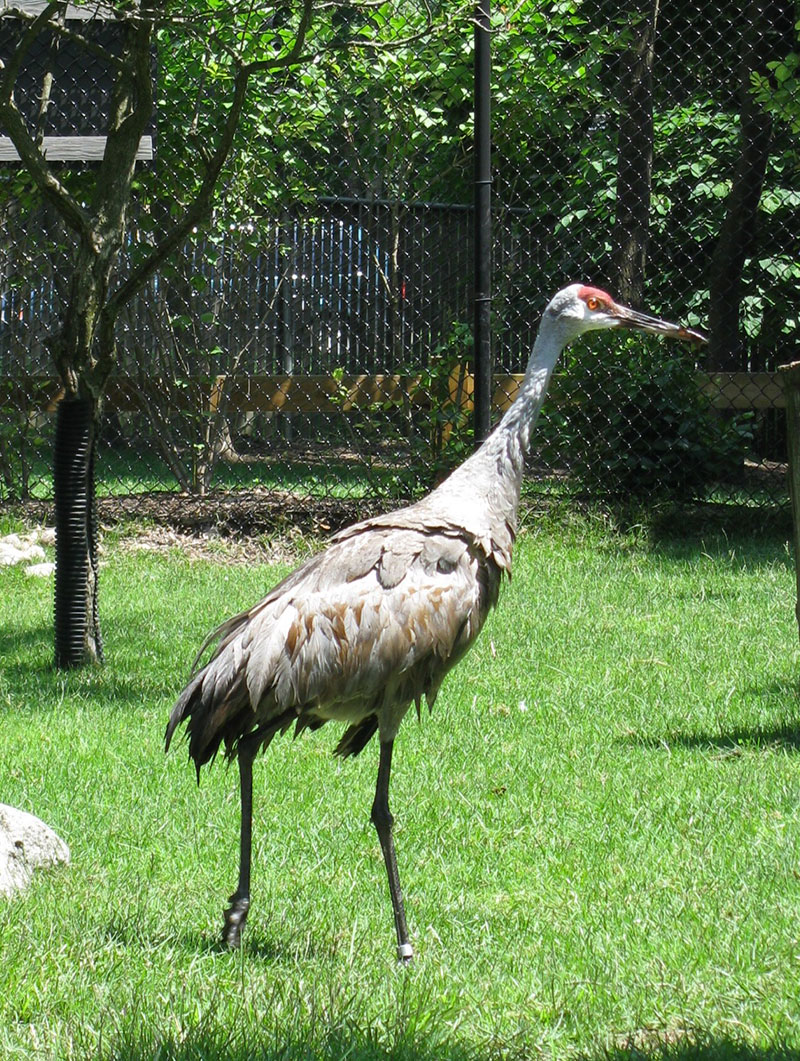Sandhill Crane
Antigone canadensis
Description:
A sandhill crane is a large gray bird with a long neck and long black legs. It has a prominent red patch on its forehead. Adults have a white patch on each cheek. Juveniles have a brown coloring that turns to gray as they age. Sandhill cranes often use their beaks to rub mud into their feathers, giving them more of a reddish-brown coloring which helps them to camouflage. Males and females are similar in appearance, although males are usually larger than the females.
Size:
Sandhill cranes are about 3-4 feet (0.9-1.2 meters) tall, with a wingspan of more than 5 feet (1.5 meters). Sandhill cranes weigh 6-7 pounds (2.7-3.2 kg).
Adaptations:
- Instead of being a straight tube, a sandhill crane’s trachea loops like a saxophone. This helps the bird to emit a call that can be heard for over a mile!
- A sandhill crane’s long, narrow legs help it to wade in shallow water.
Diet:
In the wild, the diet of a sandhill crane changes seasonally, depending on what food is available at the time. Most of a sandhill crane’s diet consists of plants and grains, but the cranes will also consume insects, small mammals, amphibians, and reptiles. At Cosley Zoo, the sandhill cranes are fed a commercial crane diet, supplemented with meat such as fish, rats, quail or mice.
Reproduction:
Sandhill cranes mate for life. Mating is preceded by an elaborate display in which the birds run, jump, toss sticks, and flap their wings. The cranes then make their nests by piling plant material into large mounds. The female lays one clutch (consisting of two eggs) per year. The male and female take turns incubating the eggs for a total of 29-32 days, and males are responsible for defending the nest against predators. After the chicks hatch, they follow their parents closely for the first two or three months, pecking food from their parents’ beaks. The chicks fledge (fly for the first time) when they are about three months old.
Shelter and space needs:
Sandhill cranes live primarily in freshwater wetlands. They are found throughout North America at various times of the year. Sandhills spend their summers in the northern Midwest and Canada. They can occasionally be seen in Illinois in the summer, since northern Illinois is on the southern border of their summer range. More often, the cranes are seen migrating through Illinois on their way to northern North America in the spring and Texas, New Mexico, and Mexico in the fall.
Life expectancy:
Sandhill cranes can live for 20 years or more.
Relationship with man:
Sandhill cranes are popular with birdwatchers, especially during migration and courtship. Some farmers have had difficulty with sandhill cranes causing damage to their crops while probing the farm fields for corn and other seeds. Scientists have now developed treatments that farmers can put on their seeds to deter this practice.
Fun Facts:
- Sandhill cranes have been nicknamed “Watchmen of the Swamp”. While on the ground eating, they will vigilantly watch for predators and if they spot danger, will emit a loud alarm call to warn other birds.
- Sandhill crane chicks are also called “colts”.
- The sandhill cranes is the most abundant crane species in the world.






